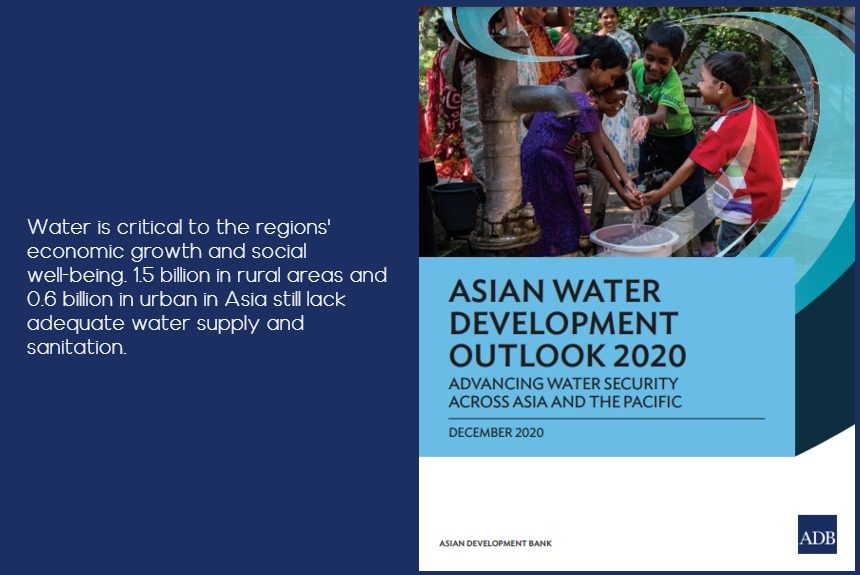Despite Asia’s impressive growth and achievement in the last decades, some countries are still lagging in good water management, according to the ADB’s 2020 report, “Asian Water Development Outlook 2020: Advancing Water Security in Asia and the Pacific” (AWDO 2020).
Water is critical to the region’s economic growth and social well-being. In Asia, 1.5 billion people in rural areas and 0.6 billion in urban areas still lack adequate water supply and sanitation.
Twenty-seven out of 49 ADB member countries face severe water constraints, and 18 are still working to protect their residents from water-related disasters.
The report describes the status of water security in Asia and the Pacific. It defines water security as “the availability of adequate water to ensure safe and affordable water supply, inclusive sanitation for all, improved livelihoods, and healthy ecosystems, with reduced water-related risks toward supporting sustainable and resilient rural-urban economies in the Asia Pacific region”.
The AWDO 2007 report states that the region’s water insecurity problem stems from inappropriate water management practices rather than water scarcity.
Measuring Water Security
To measure water security comprehensively in the region, the AWDO 2013 created a water security framework that consists of five key dimensions (KDs):
- rural household water security,
- economic water security,
- urban water security,
- environmental water security, and
- water-related disaster security.
Each KD is scored based on public data on various indicators that describe its performance. The scores are added together to form the national water security (NWS) scores. Banding is applied to these scores to indicate the NWS and KD development stages, such as nascent, engaged, capable, effective, and novel.
Scoring the national water security of all 49 ADB countries shows that none of them has achieved the model stage yet, which means there is still room for improvement.
Countries with the highest and lowest NWS scores
Countries with the highest NWS scores and reached the “effective stage”, from highest to lowest scores, are
- New Zealand
- Japan
- Australia
- South Korea
- Hong Kong and Taipei.
Singapore was just shy of reaching the “effective” stage.
The five countries with the lowest NWS scores are Afghanistan, which achieved a nascent development stage, Micronesia, Pakistan, Papua New Guinea, and India, all four of which achieved an “engaged” development stage.
These countries have serious work to do to strengthen their national water security.
The Water Security Key Dimensions and ADB’s Recommendations
The report presents the results of each ADB member and according to their regions: Central and West Asia, East Asia, the Pacific, South Asia, Southeast Asia, and Advanced Economies, on each of the five KDs and suggests recommendations on how to improve water security on every five key dimensions.
On KD #1: Rural Household Water Security
Countries and regions that have scored low on this, such as the Pacific and South Asia, recommend the following actions: Engage vulnerable people in decision-making, invest in human resources capacity, and deliver locally appropriate solutions.
Rural areas are more vulnerable to water and sanitation problems as they tend to invest more in water’s economic applications, such as agriculture than its domestic or sanitation uses.
On KD #2: Economic Water Security
East Asia has achieved the same level as advanced economies. The Pacific again lags in this dimension, with eight countries in the “nascent” stage.
The report recommends the following for these regions and countries: enhance water resources monitoring, measurement, and data availability, improve water productivity, and ensure adequate storage and distribution mechanisms.
On KD #3: Urban Water Security
East Asia’s performance is almost the same as that of the advanced economies, while the Pacific region scored low. The report says that rapid urban and peri-urban growth and climate change impacts create significant challenges for providing stormwater, wastewater, and water infrastructure.
It recommends the following to address urban water security issues: invest in sanitation, wastewater treatment, and a circular economy; improve water cost-effectiveness and affordability; and improve drainage security in the Pacific, Central and West Asia, and Southeast Asia.
On KD #4: Environmental Water Security
The scores show a mixed picture; Southeast Asia scores well, the Pacific region scores above average, and South Asia lags.
The report recommends improving pollution load management, stimulating circular economic activities, protecting natural terrestrial and aquatic systems, and reducing groundwater depletion.
On KD #5: Water-Related Disaster Security
The report says climate change will increase climate variability in extreme events like floods and droughts.
The report recommends investing in green and grey disaster infrastructure, promoting integrated flood risk management, including piloting nature-based solutions and improving data collection, modelling, and associated systems for preventive disaster risk management.
To read the entire report, click the link below:
Sources:
Asian Water Development Outlook 2020: Advancing Water Security Across Asia and the Pacific. Asian Development Bank. Retrieved from https://www.adb.org/sites/default/files/publication/663931/awdo-2020.pdf



Leave a Reply